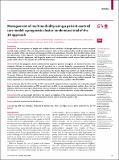Files in this item
Management of multimorbidity using a patient-centred care model : a pragmatic cluster-randomised trial of the 3D approach
Item metadata
| dc.contributor.author | Salisbury, Chris | |
| dc.contributor.author | Man, Mei-See | |
| dc.contributor.author | Bower, Peter | |
| dc.contributor.author | Guthrie, Bruce | |
| dc.contributor.author | Chaplin, Katherine | |
| dc.contributor.author | Gaunt, Daisy M. | |
| dc.contributor.author | Brookes, Sara | |
| dc.contributor.author | Fitzpatrick, Bridie | |
| dc.contributor.author | Gardner, Caroline | |
| dc.contributor.author | Hollinghurst, Sandra | |
| dc.contributor.author | Lee, Victoria | |
| dc.contributor.author | McLeod, John | |
| dc.contributor.author | Mann, Cindy | |
| dc.contributor.author | Moffat, Keith Rafie | |
| dc.contributor.author | Mercer, Stewart W. | |
| dc.date.accessioned | 2018-08-08T14:30:08Z | |
| dc.date.available | 2018-08-08T14:30:08Z | |
| dc.date.issued | 2018-07-07 | |
| dc.identifier | 253277693 | |
| dc.identifier | 74035222-fddc-4523-9905-ba77b1bd0063 | |
| dc.identifier | 85049349646 | |
| dc.identifier.citation | Salisbury , C , Man , M-S , Bower , P , Guthrie , B , Chaplin , K , Gaunt , D M , Brookes , S , Fitzpatrick , B , Gardner , C , Hollinghurst , S , Lee , V , McLeod , J , Mann , C , Moffat , K R & Mercer , S W 2018 , ' Management of multimorbidity using a patient-centred care model : a pragmatic cluster-randomised trial of the 3D approach ' , Lancet , vol. 392 , no. 10141 , pp. 41-50 . https://doi.org/10.1016/S0140-6736(18)31308-4 | en |
| dc.identifier.issn | 0140-6736 | |
| dc.identifier.uri | https://hdl.handle.net/10023/15782 | |
| dc.description | Funding: National Institute for Health Research | en |
| dc.description.abstract | BACKGROUND The management of people with multiple chronic conditions challenges health-care systems designed around single conditions. There is international consensus that care for multimorbidity should be patient-centred, focus on quality of life, and promote self-management towards agreed goals. However, there is little evidence about the effectiveness of this approach. Our hypothesis was that the patient-centred, so-called 3D approach (based on dimensions of health, depression, and drugs) for patients with multimorbidity would improve their health-related quality of life, which is the ultimate aim of the 3D intervention. METHODS We did this pragmatic cluster-randomised trial in general practices in England and Scotland. Practices were randomly allocated to continue usual care (17 practices) or to provide 6-monthly comprehensive 3D reviews, incorporating patient-centred strategies that reflected international consensus on best care (16 practices). Randomisation was computer-generated, stratified by area, and minimised by practice deprivation and list size. Adults with three or more chronic conditions were recruited. The primary outcome was quality of life (assessed with EQ-5D-5L) after 15 months' follow-up. Participants were not masked to group assignment, but analysis of outcomes was blinded. We analysed the primary outcome in the intention-to-treat population, with missing data being multiply imputed. This trial is registered as an International Standard Randomised Controlled Trial, number ISRCTN06180958. FINDINGS Between May 20, 2015, and Dec 31, 2015, we recruited 1546 patients from 33 practices and randomly assigned them to receive the intervention (n=797) or usual care (n=749). In our intention-to-treat analysis, there was no difference between trial groups in the primary outcome of quality of life (adjusted difference in mean EQ-5D-5L 0·00, 95% CI −0·02 to 0·02; p=0·93). 78 patients died, and the deaths were not considered as related to the intervention. INTERPRETATION To our knowledge, this trial is the largest investigation of the international consensus about optimal management of multimorbidity. The 3D intervention did not improve patients' quality of life. | |
| dc.format.extent | 365409 | |
| dc.language.iso | eng | |
| dc.relation.ispartof | Lancet | en |
| dc.subject | R Medicine | en |
| dc.subject | E-DAS | en |
| dc.subject.lcc | R | en |
| dc.title | Management of multimorbidity using a patient-centred care model : a pragmatic cluster-randomised trial of the 3D approach | en |
| dc.type | Journal article | en |
| dc.contributor.institution | University of St Andrews. School of Medicine | en |
| dc.identifier.doi | 10.1016/S0140-6736(18)31308-4 | |
| dc.description.status | Peer reviewed | en |
This item appears in the following Collection(s)
Items in the St Andrews Research Repository are protected by copyright, with all rights reserved, unless otherwise indicated.

